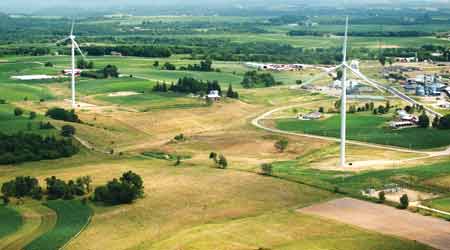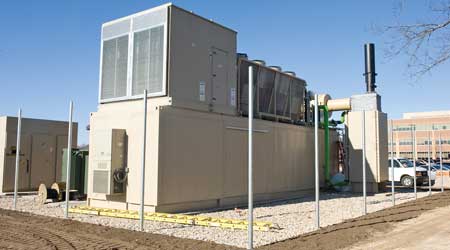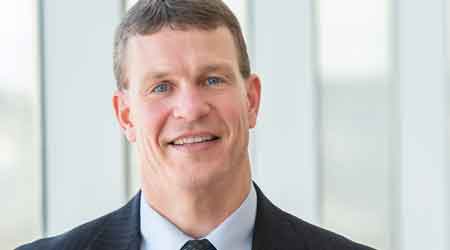Creative Renewable Energy Projects Lead to Energy Independence
Building on Gundersen Health System's long-term energy efficiency success, Corey Zarecki has deployed an ever-increasing portfolio of creative renewable energy projects.
Gundersen first achieved its energy independence goal in October 2014. Zarecki says Gundersen defines energy independence as producing more energy than the health system uses from fossil fuels. Today, Gundersen is 56 percent more efficient than in 2008 when the initiative started, saving about $3 million annually from energy efficiency improvements. While that’s an incredible achievement, far be it from Zarecki to rest on his laurels. With all that work, the question becomes: How does the system maintain this efficiency? One of the characteristics of Envision is that it’s not an official part of the Gundersen facilities department. That gives Zarecki a degree of freedom to work on projects independently, but still in close partnership with facilities. However, Eber is part of facilities and he’s the go-to guy for day-to-day energy management.
Each of the now nine largest energy-using buildings are metered and each facility has a building manager whose responsibilities include entering each day’s energy use into a spreadsheet. That may strike some as delightfully old-fashioned, but Eber says there’s a very specific reason why he’s never succumbed to the pressure of an automated energy management system. “I don’t want to see a speedometer showing how much energy our building is using,” he says. “We could use a fancy program, but unless someone is actively looking at it, it does no good. So I want our staff to be actively looking at this information, and the one way we know they’re looking at it is if they’re recording it.”
Zarecki agrees: “No matter the size of a building, someone has to take ownership of it and understand how the building ‘feels,’” he says. “A computer can’t do that.” The team has developed a regression analysis for each building to tell if something’s wrong. “If a building isn’t performing like it should, the building manager has to follow up on what happened that day,” says Rich. Sometimes, it’s just a high MRI load. Sometimes it’s something more nefarious, but correctable. The data is key to understanding what went wrong and fixing it before too much energy is wasted.
Getting creative with renewables
To get to energy independence, however, one does not live on efficiency alone. “You can’t improve all the way to zero,” says Zarecki. “So to be energy independent, you need renewables.”
As with its efficiency initiatives, Gundersen has higher goals with its renewables than just lowering its own carbon profile. “Renewables continue to be important because of emissions and their health impact,” says Rich. “Certainly, polluting is bad for the environment, but it also has a poor effect on health. As a healthcare provider, we need to look in the mirror because our mission is to prevent and cure disease.”
Another reason renewables are important, says Rich, is that they create local jobs. In the upper Midwest, “we don’t mine fossil fuels here,” he says. “But we have a lot of renewable resources. So using renewables not only helps our environment, but also helps our local economies.” Studies have shown that the better a community’s economy, the better its physical health, as well, he says.

(The Cashton wind turbine project is a 50/50 venture between Gundersen Health System and Organic Valley, a Wisconsin farming co-op. The project includes two 100-meter towers that each produce 2.499 MW of electricity. The project offsets about 6 percent of Gundersen Health System’s energy use.)
Renewable projects are the ones nearest and dearest to Zarecki’s heart. “You do energy conservation first. It’s not the sexy stuff, but what it is is fast,” he says. “Then you need less renewables to offset your energy use. Plus, with all the little successes in efficiency, you buy credibility. We got the buy-in from leadership, so now when we bring a big wind project to them, they’ll back it.”
So Zarecki and Rich have done those big wind projects, sure. They’ve also done several solar projects, both photovoltaics and thermal. They’ve turned landfill gas into electricity, which resulted in Gundersen’s Onalaska campus being the first fully energy-independent healthcare campus in the United States. Two different projects use biogas digesters to turn cow manure (of which there is plenty in Wisconsin) into electricity. They even tried a hydroelectric project in collaboration with the Army Corps of Engineers on the nearby Mississippi River — a project that was ultimately killed. You can’t win ‘em all.
But the successes far outnumber the failures. And you name it, Zarecki has probably thought about how Gundersen could do it to contribute to the system’s continuing energy independence. “With all the renewables, we had to change the paradigm to get the best economics for the project,” says Zarecki. “Where you can, do it onsite. Where you can’t, let’s go where the wind blows, where the water flows, and in the case of our digester sites, where the cows are.”

(A partnership with the La Crosse County Solid Waste Department, this biogas project uses waste biogas from the landfill to offset 100 percent of Gundersen Health System’s Onalaska campus energy usage.)
One of the characteristics that makes some of Gundersen’s renewables projects unique is that, say for an offsite wind project, the energy generated may not go directly to Gundersen facilities. Instead, it goes to the grid and Gundersen uses the offsets in the accounting towards its overall system-wide energy independence goal. They call these “grid-production” projects. Several other projects, though, are on site — a 300 kW solar system installed in July 2017 at the system’s Onalaska campus, for example, that is specifically designed to use every watt generated onsite, not exporting any to the grid.
“With the price of solar and now batteries falling dramatically, we are able to do more projects onsite and have a good payback,” says Zarecki. “The addition of batteries not only helps the intermittent nature of renewables, but it also helps improve the resilience of buildings.”
Related Topics:
















